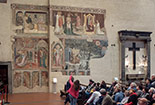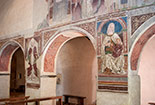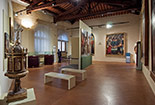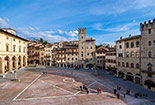The Saint Domenico's Basilica
in Arezzo, Tuscan art city that you can know in every detail with this website
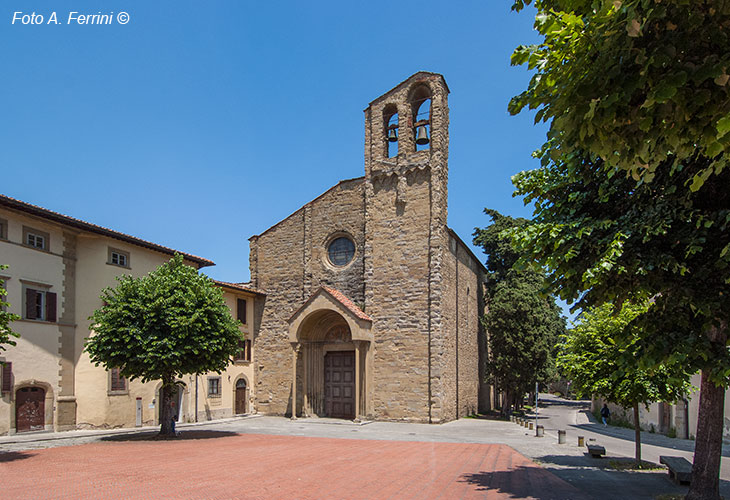
Texts and photos by Alessandro Ferrini ©
33 images in sequence of Basilica of San Domenico in Arezzo. Click to enlarge
Saint Domenico, an example of Gothic architecture in Arezzo
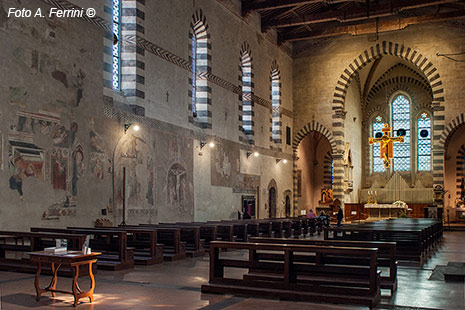 In the historic center of Arezzo, a few meters from the northern walls of the city, is the Basilica of San Domenico overlooking the square of the same name. An urban space with beautiful plants that together with the facade of the church create a pleasant architectural harmony that makes simplicity its strong point.
In the historic center of Arezzo, a few meters from the northern walls of the city, is the Basilica of San Domenico overlooking the square of the same name. An urban space with beautiful plants that together with the facade of the church create a pleasant architectural harmony that makes simplicity its strong point.
The place is located a few minutes walk from the Cathedral of San Donato, but it is very nice and easy to reach even from the car park in Via Pietri, more known as "parking of escalators". From here, without using this mechanized means of transport, you can get to the historic center of Arezzo through a pedestrian street that, slightly uphill and among the greenery, leads us to an ancient door on the walls: Porta Pozzuolo, of thirteenth-century origin. After this, we are a few meters from the back of the church.
Before talking about this sacred building in Arezzo, it is worth remembering that Domenico di Guzmàn, born in Caleruegua (Spain) in 1170, died in Bologna in August 1221 and canonized already in 1234, founded in 1216 the Order of the Friars Preachers, which was approved in December of the same year by Pope Honorius III. Immediately the followers of St. Dominic began to move and settle in many places, first Italian and Spanish, then European.
These Friars Preachers, who distinguished themselves by being great scholars in many disciplines, arrived in Arezzo in the late twenties of the thirteenth century. If at the beginning they were guests in other religious structures,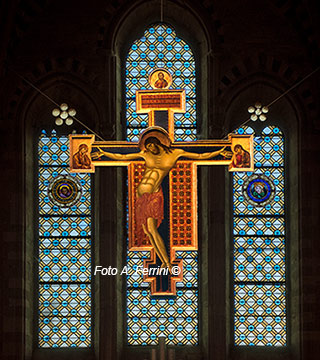 by the middle of the century they already had their own convent with an adjoining oratory. They were welcomed in the city, for the new message of San Domenico that brought together a wave of culture. In a few years this religious reality became increasingly important, hence the need to have their own church that through the pages of this web section we will know in many architectural and artistic details.
by the middle of the century they already had their own convent with an adjoining oratory. They were welcomed in the city, for the new message of San Domenico that brought together a wave of culture. In a few years this religious reality became increasingly important, hence the need to have their own church that through the pages of this web section we will know in many architectural and artistic details.
The construction of the Church of San Domenico began in 1275 (two years before the cathedral) and ended at the beginning of the fourteenth century. Most of it was financed by two important and powerful families: the Ubertini and the Tarlati. Both had in that period two great bishops of Arezzo: Guglielmo degli Ubertini who was bishop at the time of construction, Guido Tarlati who was proclaimed bishop in 1312.
Given the period, the church was built in Gothic style. Its asymmetrical facade, remained unfinished, as it still is today. The small bell tower gives elegance to this front part of the building. In this are two bells, one from 1349, the other from 1556. The facade is also characterized by a sort of small loggia leaning against the entrance door. But this architectural element is relatively recent. It was built in the 1930s to protect an early 16th century fresco painted in the lunette above the door.
The interior of the Church of San Domenico, which was elected Basilica in 1960, has a single hall with trussed roofing. Its natural lighting is guaranteed by the rose window on the facade, the large windows behind the high altar, the six single-lancet windows on the wall. 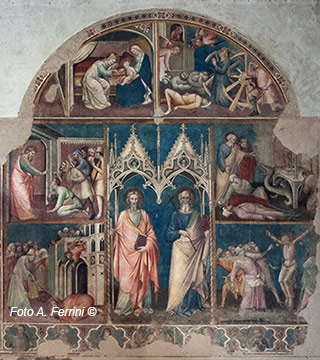 These, for their elongated shape, are the elements that immediately give the idea of the Gothic style that in the rest of the building is not particularly accentuated. In addition, the twelve single lancet windows have a sort of black and white frame around them that could also be a reminder of the Dominican style, certainly in this way they are very evident on the dark walls. Another peculiarity is that they are not equidistant. As we approach the presbytery area there is less space between them. This increases the perspective effect of the church by looking at it from the entrance door.
These, for their elongated shape, are the elements that immediately give the idea of the Gothic style that in the rest of the building is not particularly accentuated. In addition, the twelve single lancet windows have a sort of black and white frame around them that could also be a reminder of the Dominican style, certainly in this way they are very evident on the dark walls. Another peculiarity is that they are not equidistant. As we approach the presbytery area there is less space between them. This increases the perspective effect of the church by looking at it from the entrance door.
The fame of the Basilica of San Domenico in Arezzo is due to its artistic aspect. From the third decade of the fourteenth century to the early sixteenth century, on the walls of the church painted the most famous painters of the city. Of all these frescoes, today some are still intact, some have been lost, others remain significant parts or just fragments. Here we find many paintings by artists such as Spinello Aretino, his son Parri di Spinello, Donato and Gregorio d'Arezzo, Montano d'Arezzo, the Maestro del Vescovato, Angelo di Lorentino, Giovanni d'Agnolo di Balduccio and others. In the Dominican church there are not only frescoes, there is also a beautiful triptych on a gold background always by the Maestro del Vescovato, a San Pietro da Verona in glazed terracotta of the Della Robbia school and a fourteenth-century Madonna and Child carved on stone. Finally, but primarily as an artistic value, the church preserves an extraordinary work of Cimabue's youth: A large painted cross placed high above the high altar, dating from 1265 to 1260. A feather in the cap not only for the Basilica of San Domenico, but for the entire city of Arezzo.



